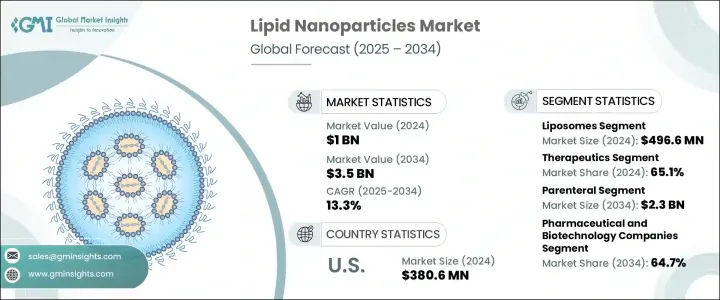
세계의 지질 나노입자 시장 규모는 2024년에는 10억 달러로 평가되었고, 특히 백신과 유전자 의약 등 mRNA 기반 치료제에 대한 수요 증가에 견인되어 CAGR 13.3%로 성장할 전망이며, 2034년까지는 35억 달러에 이를 것으로 추정되고 있습니다.
mRNA의 전달에서 지질 나노입자의 사용은 취약한 mRNA 분자를 보호하고 세포 내로의 안전하고 효율적인 수송을 촉진하는 능력에 의해 큰 주목을 받고 있습니다. mRNA 백신 분야에서의 이러한 성공은 LNP 기술에 대한 투자와 연구를 활성화시켰고, 그 용도를 감염병에 그치지 않고 암 면역 요법, 단백질 대체 요법, 희귀 유전 질환 치료 등의 분야로 끌고 갔습니다.

생명 공학 및 제약 회사가 새로운 세대의 mRNA 기반 치료법을 개발함에 따라 LNP와 같은 최적화 된 전달 시스템에 대한 수요가 급증할 것으로 예측됩니다. 지질 조성, 스케일러빌리티, 제조 프로세스의 진보에 의해, 임상 용도를 향한 LNP의 이용 가능성이 높아져, 시장의 확대에 한층 더 박차를 가하고 있습니다. LNP는 약물 전달의 중요한 구성요소로 핵산, 단백질, 저분자 등의 치료제를 캡슐화하기 때문에 폭넓은 의료 용도에 필수적입니다.
| 시장 범위 | |
|---|---|
| 시작 연도 | 2024년 |
| 예측 연도 | 2025-2034년 |
| 시작 금액 | 10억 달러 |
| 예측 금액 | 35억 달러 |
| CAGR | 13.3% |
2024년 시장 규모는 4억 9,660만 달러로 평가되었고, 리포솜 부문이 시장을 선도했습니다. 지질 이중막으로 구성된 리포좀은 약물 전달 시스템에서 매우 효율적이며 약제의 안정성과 바이오 어베이러빌리티에 있어 우위성을 발휘합니다. 그 범용성 때문에 특히 종양 치료에 있어서 인기가 높아지고 있습니다. 게다가 나노기술의 진보로 리포좀 제제가 개량되어 약제 충전 효율과 방출 제어 프로파일이 향상되어 시장 점유율을 더욱 끌어올리고 있습니다.
치료제 부문은 2024년에 65.1%의 점유율을 차지했으며, 13%의 안정적인 성장률로 시장을 독점했습니다. LNP는 mRNA, siRNA, DNA 등 핵산 기반 약제를 전달해 다양한 질환을 치료하는 데 도움을 줍니다. 특히 암, 감염증, 유전성 질환에서 약제의 안정성을 높이고 정확하게 배달할 수 있어 차세대 의약품 개발의 플랫폼으로 선호되고 있습니다. 세계 승인 취득과 임상시험 진행에 따라 치료제 부문은 우위를 유지할 것으로 예상됩니다.
미국의 지질 나노입자 시장은 2023년 3억 3,420만 달러에서 2024년에는 3억 8,060만 달러에 이르렀으며, 2034년까지 연평균 복합 성장률(CAGR) 12.7%를 보일 것으로 예측됩니다. 미국은, 강고한 바이오 테크놀로지와 제약 산업, 충실한 연구 개발 투자, 양호한 규제 환경에 힘입어, 이 시장에서의 주도적 지위를 견지하고 있습니다. 기술 혁신이 진행되고 공동 연구가 확대됨에 따라 미국이 시장을 계속 선도할 가능성이 높습니다.
세계의 지질 나노입자 업계에서는 Cayman Chemicals, Arcturus Therapeutics, Alnylam Pharmaceuticals, Moderna, BioNTech SE, Sigma-Tau Pharmaceuticals, Evonik, Merck, Ascendia Pharmaceuticals, ABP Biosciences, Creative Biostructure, Diant Pharmaceuticals, Diant Pharmaceuticals Scientific, Acuitas Therapeutics 등이 저명 기업입니다 세계의 지질 나노입자 시장에서 각사가 자사의 지위를 강화하기 위해 채용하고 있는 주요 전략에는 LNP 전달 시스템을 강화하기 위한 연구 개발 투자 증가, 유전자 치료나 암 면역 치료에 대한 새로운 용도의 모습 색인, 제품 제공을 확대하기 위한 전략적 파트너십의 형성 등이 있습니다. 또한, 기업은 확장성과 비용 효과를 확보하기 위해 제조 공정의 개선에 주력하고 있으며, LNP 기반 치료제에 대한 수요 증가에 대응할 수 있도록 하고 있습니다.
The Global Lipid Nanoparticles Market was valued at USD 1 billion in 2024, and it is estimated to grow at a CAGR of 13.3% to reach USD 3.5 billion by 2034, driven by the increasing demand for mRNA-based therapeutics, particularly in vaccines and genetic medicines. The use of lipid nanoparticles in the delivery of mRNA has gained significant attention due to their ability to protect fragile mRNA molecules, facilitating their safe and efficient transport into cells. This success in the mRNA vaccine space has sparked greater investment and research in LNP technologies, pushing their applications beyond infectious diseases into areas like cancer immunotherapy, protein replacement therapies, and treatments for rare genetic disorders.

The demand for optimized delivery systems like LNPs is expected to surge as biotech and pharmaceutical companies develop new generations of mRNA-based treatments. Advances in lipid composition, scalability, and manufacturing processes have enhanced the availability of LNPs for clinical applications, further fueling market expansion. LNPs are a key component in drug delivery, encapsulating therapeutic agents such as nucleic acids, proteins, and small molecules, making them critical for a wide range of medical applications.
| Market Scope | |
|---|---|
| Start Year | 2024 |
| Forecast Year | 2025-2034 |
| Start Value | $1 Billion |
| Forecast Value | $3.5 Billion |
| CAGR | 13.3% |
The liposomes segment led the market in 2024, with a value of USD 496.6 million. Liposomes, composed of lipid bilayers, are highly efficient in drug delivery systems, offering advantages in drug stability and bioavailability. Their versatility, especially in oncology treatments, has grown their popularity. In addition, advancements in nanotechnology are improving liposomal formulations, increasing their drug loading efficiency and controlled release profiles, further boosting their market share.
The therapeutics segment dominated the market with a 65.1% share in 2024, growing at a steady rate of 13%. LNPs help deliver nucleic acid-based drugs such as mRNA, siRNA, and DNA to treat various diseases. Their ability to enhance drug stability and precision delivery, particularly in cancer, infectious diseases, and genetic disorders, has made them a preferred platform in next-generation drug development. With more global approvals and clinical trials underway, the therapeutics segment is expected to maintain its dominance.
United States Lipid Nanoparticles Market reached USD 380.6 million in 2024, growing from USD 334.2 million in 2023, and is expected to grow at a CAGR of 12.7% through 2034. The U.S. maintains a strong leadership position in the market, supported by its robust biotechnology and pharmaceutical industries, substantial R&D investments, and favorable regulatory environment. As innovations continue and collaborations expand, the U.S. will likely continue to lead the market.
Prominent players in the Global Lipid Nanoparticles Industry include Cayman Chemicals, Arcturus Therapeutics, Alnylam Pharmaceuticals, Moderna, BioNTech SE, Sigma-Tau Pharmaceuticals, Evonik, Merck, Ascendia Pharmaceuticals, ABP Biosciences, Creative Biostructure, Diant Pharma, Bayer, ThermoFischer Scientific, and Acuitas Therapeutics. Key strategies adopted by companies in the Global Lipid Nanoparticles Market to strengthen their position include increasing R&D investments to enhance LNP delivery systems, exploring new applications in gene therapies and cancer immunotherapies, and forming strategic partnerships to expand their product offerings. Additionally, companies are focused on improving manufacturing processes to ensure scalability and cost-effectiveness, enabling them to meet the growing demand for LNP-based therapeutics.